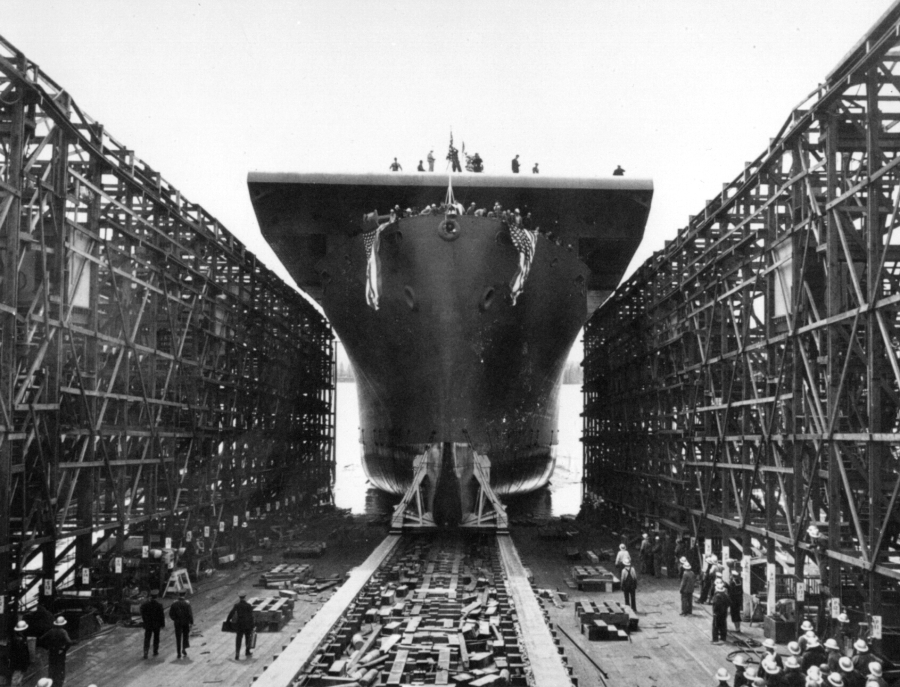Vancouver’s World War II shipyard was a historical milestone for the United States and Vancouver … as well as for some families.
Now the Kaiser Shipyard is the focus of a new exhibit that opens Saturday at Pearson Air Museum.
Shipyard production included 50 escort aircraft carriers. They provide the link to the museum’s mission of sharing Northwest aviation history, said Bob Cromwell, chief of interpretation at Fort Vancouver National Historic Site.
As they produced ships for the Navy, the Kaiser Shipyard workers also were “changing Vancouver into the city we know today,” Cromwell said.
While some families came here and wound up with jobs, a few people came here for jobs and also wound up with families.
That is part of Joye Mercer Barksdale’s family tree; her parents met in Vancouver during the shipyard years.
“My mom’s family moved to Vancouver from Huntsville, Ala., in the early ’40s for work, and my mom worked at the shipyard for a time,” Barksdale said.
Barksdale, a Maryland resident was able to retrace her family’s path when she visited Vancouver in June for a conference of education communicators.
Barksdale said that her mother was a shipyard painter.
“I have an old paycheck of hers that she had laminated — dated July 15, 1945, when she was 20.”
Her father was a Washington, D.C., native who came to Vancouver for work: “Maybe to make good money in between semesters at college,” Barksdale said.
“That’s when he met my mom. My dad was a teacher and later a principal in D.C.”
“Neither of our parents talked much about their experiences in Vancouver, at least not to us, but the fact that my mom kept her final paycheck — for the grand total of 29 cents — says a lot. Knowing my mom, I’d imagine she was always proud of the part she played in the war effort and kept the check as a memento of that time.”
Her mother, who died in November 2016 at age 91, held a number of federal jobs in Washington, D.C.
Barksdale said that her mother “even traveled to Uganda in the late ’80s when she was a secretary with the Agency for International Development. Maybe holding onto the paycheck also reminded her that she’d come a long way in her personal and work life.”
An uncashed paycheck also is part of a Vancouver family’s shipyard legacy. Sharon Chipman recently showed the final check issued to her mother, Dorothy Scott. It was worth 68 cents. Scott’s total pay for her final seven hours of work as an electrician actually came to $10.56. But that was before deductions, including $6.25 for a war bond.
Three members of her family worked at the shipyard, including two grandparents, Chipman said.
She had a chance a few days ago to look through family keepsakes with her aunt, Joyce Stalcup, who was Dorothy Scott’s sister.
If You Go
• What: Kaiser Shipyard Exhibit.
• Where: Pearson Air Museum, 1115 E. Fifth St., Vancouver.
• When:The exhibit’s opening is 2 p.m. Saturday; the museum is open Tuesday through Saturday, 9 a.m. to 5 p.m. The exhibit will be on display indefinitely.
• Admission:Free.
Stalcup’s father, Leonard Larson, was a welder and her mother, Irene Larson, was a supervisor.
All those workers were among the Kaiser employees who came here from all across the United States. The shipyard eventually employed 38,000, making it the biggest employer in Clark County history.
But the shipyard was only part of the carriers’ story. After starting their lives as job sites, the escort carriers made the transition to combat platforms. Fourteen Vancouver-built escort carriers fought in the Battle of Leyte Gulf. They were part of a task force that turned back a much larger Japanese naval force during the Allied invasion of the Philippines.
Nicknamed baby flat-tops, the escorts were about 500 feet long, with about 850 officers and enlisted men, and about 30 aircraft. (The Yorktown-class carriers were twice as big, with three times the personnel and aircraft.)
Industrialist Henry J. Kaiser use an assembly-line approach here and at his two shipyards in Portland. Eventually, the Vancouver shipyard was able to shave the time needed to produce an aircraft carrier from eight months down to about 3 1/2 months.
The Pearson exhibit will include artifacts recovered by archaeologists from the industrial site, as well as reproductions of historic photos and documents in the Fort Vancouver museum collection. There also will be a model of the USS Gambier Bay, which was sunk by Japanese warships during the Battle of Leyte Gulf.
A 13-minute documentary will chronicle the history and legacy of the shipyards through interviews with former shipyard workers, along with photographs and film archives. The video will be shown in the Tex Rankin Theater at Pearson Air Museum, and will be available for viewing on request in the Fort Vancouver Visitor Center, 1501 E. Evergreen Blvd.




